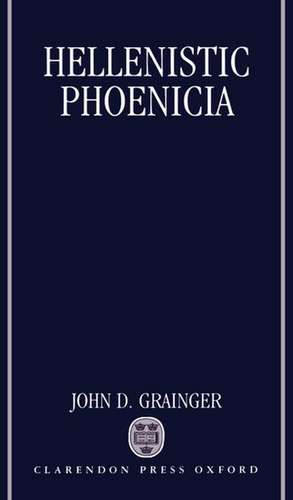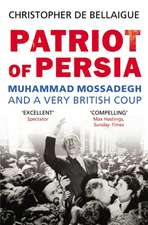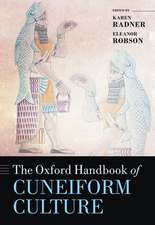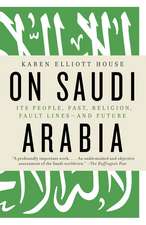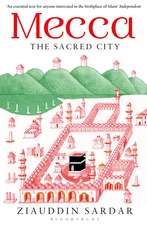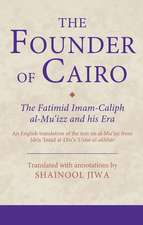Hellenistic Phoenicia
Autor John D. Graingeren Limba Engleză Hardback – 7 noi 1991
Preț: 1327.15 lei
Preț vechi: 2023.16 lei
-34% Nou
Puncte Express: 1991
Preț estimativ în valută:
253.98€ • 262.02$ • 214.96£
253.98€ • 262.02$ • 214.96£
Carte tipărită la comandă
Livrare economică 21-27 februarie
Preluare comenzi: 021 569.72.76
Specificații
ISBN-13: 9780198147701
ISBN-10: 0198147708
Pagini: 238
Ilustrații: 7 maps
Dimensiuni: 147 x 224 x 22 mm
Greutate: 0.41 kg
Ediția:New.
Editura: Clarendon Press
Colecția Clarendon Press
Locul publicării:Oxford, United Kingdom
ISBN-10: 0198147708
Pagini: 238
Ilustrații: 7 maps
Dimensiuni: 147 x 224 x 22 mm
Greutate: 0.41 kg
Ediția:New.
Editura: Clarendon Press
Colecția Clarendon Press
Locul publicării:Oxford, United Kingdom
Recenzii
After Alexander the Great sacked Tyre in 332 B.C. the Phoenicians practically drop out of history. John D. Grainger makes a scholarly and diligent effort to recover them in the first full-length modern study of the long Phoenician twillight under Greco-Macedonian rule.
substantial merits of this book. It abounds in acute observations and, far more than many books of which the same might be said, fills a real gap, contributing substantially to a growing body of new work on the "other" side of the Hellenistic world.
This book is a most welcome contribution to the study of the Phoenicians...There is not doubt at all that Grainger's book is a solid piece of scholarly work. Besides, Grainger writes in a very clear style which is free from jargon. His reasoning is very cogent and his methodological approach is very sane... Grainger has definitely made a contribution to the area of Phoenician studies, especially to those scholars interested in the Phoenicians of the Levant during the Hellenistic period. He has written in such lucid English, that even the layman can enjoy this scholarly book.
Thus G. provides a good survey and discussion of the limited evidence regarding the political histories of the cities of Hellenistic Phoenicia in the Hellenistic period. Grainger does a good job of bringing the scattered evidence for his subject together and raises interesting questions.
John Granger ... here makes sense of a difficult and neglected topic ... Grainger has used every conceivable scrap of evidence - literary, epigraphical, numismatic, and archaeological ... this is sound scholarship.
Graingr is good on use of literary sources and good on numismatics. His maps, and comments on archaeological remains, are illuminating. The discussion of the relevance of epigraphical texts to the understanding of Phoenician trade ... is very clear and balanced. This is par excellence, then, an academic monograph for the nineties.
Many will find of considerable interest the examination of Central Places theory in the light of the Hellenistic data
substantial merits of this book. It abounds in acute observations and, far more than many books of which the same might be said, fills a real gap, contributing substantially to a growing body of new work on the "other" side of the Hellenistic world.
This book is a most welcome contribution to the study of the Phoenicians...There is not doubt at all that Grainger's book is a solid piece of scholarly work. Besides, Grainger writes in a very clear style which is free from jargon. His reasoning is very cogent and his methodological approach is very sane... Grainger has definitely made a contribution to the area of Phoenician studies, especially to those scholars interested in the Phoenicians of the Levant during the Hellenistic period. He has written in such lucid English, that even the layman can enjoy this scholarly book.
Thus G. provides a good survey and discussion of the limited evidence regarding the political histories of the cities of Hellenistic Phoenicia in the Hellenistic period. Grainger does a good job of bringing the scattered evidence for his subject together and raises interesting questions.
John Granger ... here makes sense of a difficult and neglected topic ... Grainger has used every conceivable scrap of evidence - literary, epigraphical, numismatic, and archaeological ... this is sound scholarship.
Graingr is good on use of literary sources and good on numismatics. His maps, and comments on archaeological remains, are illuminating. The discussion of the relevance of epigraphical texts to the understanding of Phoenician trade ... is very clear and balanced. This is par excellence, then, an academic monograph for the nineties.
Many will find of considerable interest the examination of Central Places theory in the light of the Hellenistic data
